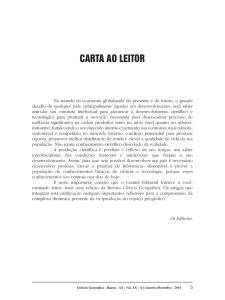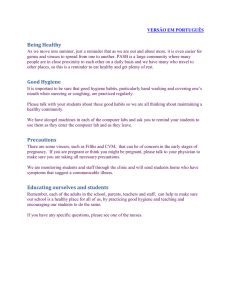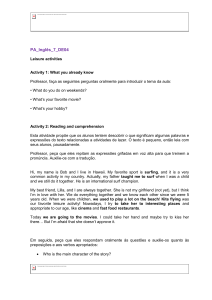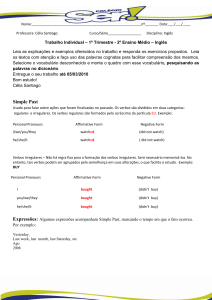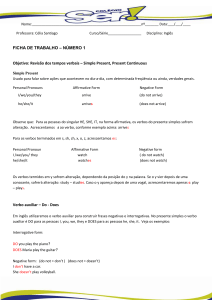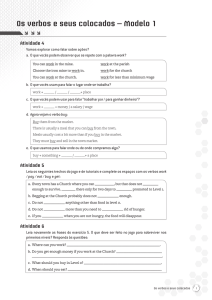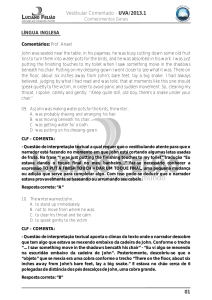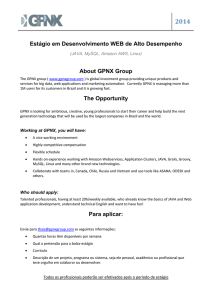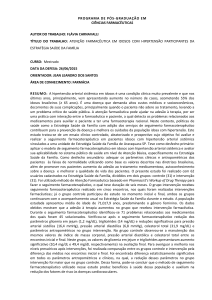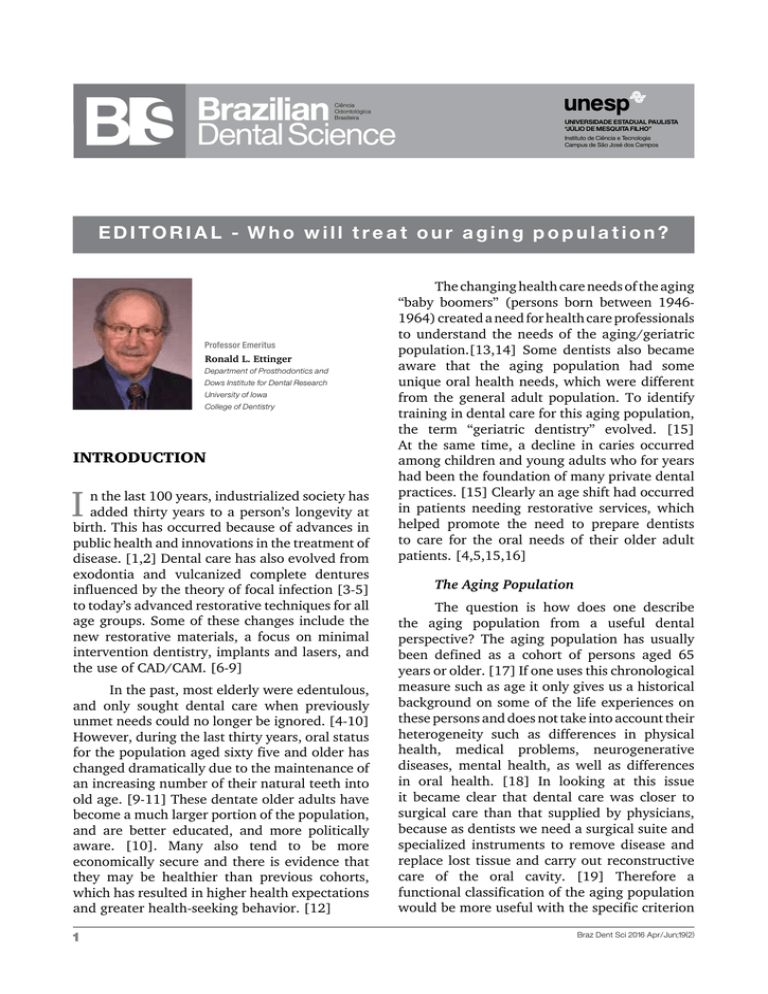
Ettinger EL et al.
Ciência
Odontológica
Brasileira
Who will treat our
aging population?
UNIVERSIDADE ESTADUAL PAULISTA
“JÚLIO DE MESQUITA FILHO”
Instituto de Ciência e Tecnologia
Campus de São José dos Campos
E D I TO R I A L - W h o w i l l t re a t o u r a g i n g p o p u l a t i o n ?
Professor Emeritus
Ronald L. Ettinger
Department of Prosthodontics and
Dows Institute for Dental Research
University of Iowa
College of Dentistry
INTRODUCTION
I
n the last 100 years, industrialized society has
added thirty years to a person’s longevity at
birth. This has occurred because of advances in
public health and innovations in the treatment of
disease. [1,2] Dental care has also evolved from
exodontia and vulcanized complete dentures
influenced by the theory of focal infection [3-5]
to today’s advanced restorative techniques for all
age groups. Some of these changes include the
new restorative materials, a focus on minimal
intervention dentistry, implants and lasers, and
the use of CAD/CAM. [6-9]
In the past, most elderly were edentulous,
and only sought dental care when previously
unmet needs could no longer be ignored. [4-10]
However, during the last thirty years, oral status
for the population aged sixty five and older has
changed dramatically due to the maintenance of
an increasing number of their natural teeth into
old age. [9-11] These dentate older adults have
become a much larger portion of the population,
and are better educated, and more politically
aware. [10]. Many also tend to be more
economically secure and there is evidence that
they may be healthier than previous cohorts,
which has resulted in higher health expectations
and greater health-seeking behavior. [12]
1
The changing health care needs of the aging
“baby boomers” (persons born between 19461964) created a need for health care professionals
to understand the needs of the aging/geriatric
population.[13,14] Some dentists also became
aware that the aging population had some
unique oral health needs, which were different
from the general adult population. To identify
training in dental care for this aging population,
the term “geriatric dentistry” evolved. [15]
At the same time, a decline in caries occurred
among children and young adults who for years
had been the foundation of many private dental
practices. [15] Clearly an age shift had occurred
in patients needing restorative services, which
helped promote the need to prepare dentists
to care for the oral needs of their older adult
patients. [4,5,15,16]
The Aging Population
The question is how does one describe
the aging population from a useful dental
perspective? The aging population has usually
been defined as a cohort of persons aged 65
years or older. [17] If one uses this chronological
measure such as age it only gives us a historical
background on some of the life experiences on
these persons and does not take into account their
heterogeneity such as differences in physical
health, medical problems, neurogenerative
diseases, mental health, as well as differences
in oral health. [18] In looking at this issue
it became clear that dental care was closer to
surgical care than that supplied by physicians,
because as dentists we need a surgical suite and
specialized instruments to remove disease and
replace lost tissue and carry out reconstructive
care of the oral cavity. [19] Therefore a
functional classification of the aging population
would be more useful with the specific criterion
Braz Dent Sci 2016 Apr/Jun;19(2)
Ettinger EL et al.
being could the patient come to the dental office
either independently or with help? [20]
Currently the majority (95%) of persons
in the U.S.A. aged 65 and older live in the
community. About 70% of this population
over the age of 65 (or about 24.3 million
persons) who are living in the community are
able to visit the dentist’s office independently
[21] and can be designated as functionally
independent older adults. Many of these older
adults are living with some chronic medical
problems such as hypertension, type II diabetes,
osteoarthritis, etc., for which they are taking a
variety of medications. In terms of oral health
care, providing their dental practitioner takes
a thorough medical and drug history and
understands how his/her patients’ medical
problems and medications can influence oral
health care, their treatment will depend on the
patients’ or their significant others’ perception
of need and the amount of money they are
prepared to pay for it. These topics should have
been taught in oral medicine and pharmacology
classes in dental school and in their didactic
geriatric dentistry class. These older adults
can access dental care independently using
their own vehicles or public transportation. In
addition, for well and ambulatory elderly, a
few modifications in office design to allow for
normal aging changes will allow private general
practitioners to treat this population. [22-29]
However, 20% of these older adults
over the age of 65 years can be quite frail and
medically compromised. These frail older adults
are those persons who have lost some of their
independence but still live in the community
with the help of family and friends or who are
using professional and community support
services such as Meals on Wheels (where
volunteers bring a midday meal to a frail older
adult), visiting nurses, home health aides, etc.
The greater majority of these older adults can no
longer access general dental services without the
help of others. Their oral health needs require
that the dentist have a greater understanding of
medicine and pharmacology and a make a careful
evaluation of the patient’s ability to maintain
2
Who will treat our
aging population?
daily oral hygiene independently, as well as
their ability to tolerate treatment. These persons
can still be cared for by a general dentist in his/
her office provided he/she has some further
postgraduate experience in a hospital-based
General Practice Residency (GPR) or has taken
some focused continuing education courses.
This leaves about 5% or 1.8 million persons
over the age of 65 years who at any one time
are living in 17,000 institutions in the U.S.A. and
another 5% who are homebound. These persons
are functionally dependent older adults and are
persons who clearly no longer capable of surviving
in the community independently. Some of these
older adults may be able to access dental services
if they are transported to a dentist’s office, a
community clinic or a hospital outpatient clinic.
Many of these persons use wheelchairs, so if a
dentist wishes to care for such a patient, his/her
dental office needs to be wheelchair accessible.
If the person cannot be transported, then the
services need to be brought to them through
mobile programs. Therefore, if a general dentist
wishes to treat residents in nursing homes, he/
she needs to have the will, the experience and
access to mobile equipment, if he/she wishes
to visit the patient or the institution in which
the older adult resides. If that institution has a
dental facility, that is a bonus.
It has been projected that 20% of persons
over age 65 years will spend at least part of
their life in a nursing home. [22] The estimated
5% or 1.8 million frail individuals who are
homebound tend not to seek elective services
and are not inclined to volunteer for any studies,
so their specific dental problems remain mainly
underdocumented.
For non-ambulatory nursing home
residents and for homebound people, new
delivery systems are needed. There are
potentially five methods of dental care delivery
for homebound and institutionalized elderly and
each has advantages and disadvantages. The five
methods are: transfer to a dental office; on-site
dental programs; mobile dental vans; portable
dentistry interventions; and hospitalbased
mobile programs [30,31].
Braz Dent Sci 2016 Apr/Jun;19(2)
Ettinger EL et al.
Cost-effective dental care can be delivered
to nursing home residents and hospital patients,
but delivering care for individuals who are
homebound is more complex. There are many
inefficiencies due to traveling time, setting up
the equipment, treatment for only one patient
and then the equipment needs to be dismantled
and stored and returned. Realistically, this
allows no more than three patients to be treated
per half day even when they are geographically
close. [32] Other possible problems are related to
communication, such as obtaining an adequate
history (especially a medical history, which often
means calling the patient’s physician and waiting
for a response). Communicating with the patient
or the designated person who is responsible for
his/her health decisions and getting informed
consent may be difficult. Another difficult
problem is funding. Who will pay for the care?
Who is the financial responsible party? Who will
reimburse the dentist at an adequate level to
cover expenses? [33]
Role of the hygienist
The dental hygienist, if they can work
without the direct supervision of a dentist, can
be a key participant in the delivery of oral health
care for the homebound, and also for frail and
dependent persons residing in any type of longterm care facility. The hygienist’s role as part
of the clinical team is to perform any clinical
hygiene procedure necessary and to develop
and maintain oral hygiene care plans for each
resident. The hygienist also provides ‘hands-on’
regular in-service training for the long-term care
staff and support for the nursing home staff, and
assists the staff with incorporating oral hygiene
care into residents’ personal care plans.
Role of the consultant dentist
Ideally, every nursing home or institution
should have a consultant dentist who has a
contractual agreement with the facility to carry
out a comprehensive dental examination for each
resident within two weeks of being admitted to
the facility . The consultant should also examine
all residents at least once a year and treat all
3
Who will treat our
aging population?
of the consenting residents who choose to seek
treatment. The consultant dentist needs to work
with the administrator, the director of nursing
and the medical director/consultant to develop
a dental program that suits the policy and
procedural needs of the nursing home. [33]
In a Department of Health and Human
Services report to the United States Congress
[34] entitled “Personal for health needs of the
elderly through year 2020,” it was projected
that there would be a need for at least 6,000
dentists in the U.S.A. with substantial training
in geriatric dentistry by the year 2000. This
report also projected a need for another 2000
dentists to be minimally trained. In a review
paper looking at post-graduate training in the
U.S.A., if one adds up all the dentists who have
been trained in geriatric dentistry since the
1980s, one would perhaps find between 200250 dentists. During this time the population
aged 65 and older increased from 11.3%
(25.5 million) of the population to 13.2% (42
million), [35] Clearly there are not enough
trained dentists to care for the most complex
functionally dependent older adults.
Summary
In 2004, [36] we wrote “There is
no established career structure for people
graduating from U.S. fellowship programs in
geriatric dentistry unless they also complete
a masters degree in public health or dental
public health or similar area.” In conjunction
with this problem, currently many hospital
general practice residency (GPR) programs
which care for medically compromised patients
are struggling financially or closing their
programs so that a cadre of trained dentists
is lost. In addition, current academic salaries
are not very competitive with the private
sector so well-trained dentists are not staying
on as teachers. If dentists in the private sector
of the U.S. wish to care for frail, functionally
dependent, cognitively impaired, or terminally
ill patients, the subsidized reimbursement for
these patients, if there is any, will depend
upon the state in which they live and in most
Braz Dent Sci 2016 Apr/Jun;19(2)
Ettinger EL et al.
states that funding is poor or nonexistent. The
barriers to care and access to care for the atrisk older population is significant.
Who will treat our
aging population?
18.
Lowsky DJ Olshansky SJ Bhattacharya J GoldmanDP.
Heterogeneity in healthy aging. J Gerontol A Biol Sci Med Sci
2014;69:640-9.
19.
Ettinger RL. Clinical training for geriatric dentistry. Gerodontics
1987;3:275-9.
20. Ettinger RL, Beck JD. Geriatric dental curriculum and the needs of
the elderly. Spec Care Dentist. 1984 Sep-Oct;4(5):207-13.
References
1.
U.S. Census Bureau, Population Projections Branch. “Aging in the
Americas into the XXI century.” 2010.
2.
United Nations. Department of Economic and Social Affairs.
Population Division, . World population ageing: 1950 -2050. New
York: United Nations, 2011. Available: www.un.org/esa/population/
publications/worldageing1950-2050 (accessed 2016 April 26th).
3.
Hunter W. An address of the role of sepsis and antisepsis in
medicine. Lancet 1911;1:79-86.
4.
Ettinger RL. Cohort differences among aging populations:
A challenge for the dental profession. Spec Care Dentist
1993;13(1):19-26.
5.
White BA, Caplan DJ, Weintraub JA. A quarter century of changes
in oral health in the United States. J Dent Educ 1995;59(1):19-57.
6.
Kapos T, Ashy LM, Gallucci GO, Weber HP, Wismeijer D. Computeraided design and computer-assisted manufacturing in prosthetic
implant dentistry. Int J Oral Maxillofac Implants 2009;24
Suppl:110-7.
7.
Stanford CM. Dental implants: A role in geriatric dentistry for the
general practice? J Am Dent Assoc 2007;138 Suppl:34S-40S.
8.
Bader C, Krejci I. Indications and limitations of Er:YAG laser
applications in dentistry. Am J Dent. 2006;19(3):178-86.
9.
Ahacic K, Thorslund M. Changes in dental status and dental care
utilization in the Swedish population over three decades: age,
period, or cohort effects? Community Dent Oral Epidemiol. 2008
Apr;36(2):118-27
10.
Ettinger RL, Beck JD. The new elderly: what can the dental
profession expect? Spec Care Dentist 1982;2(2):62-9.
11.
Chalmers JM, Carter KD, Spencer AJ. Caries incidence and
increments in community-living older adults with and without
dementia. Gerodontology 2002;19(2):80-94.
12.
Kranarow E, Lubitz J, Lentzner H, Gorina Y. Trends in the health of
older Americans, 1970-2005. Health Aff 2007;26(5):1417-25.
13.
Cohn D Taylor P. Baby boomers Approach 65 – Glumly.
Pew research Center 2010. http://www.pewsocialtrends.
org/2010/12/20baby-boomers-approach-65-glumly/ accessed
April 22 2016.
14.
Ortman JM, Velkoff VA Hogan H. An aging nation: The older
population in the United States. Current Population Reports, U.S.
Census Bureau. P25-1140 Issued May 2014.
15.
Ettinger RL. A 30-year review of a geriatric dentistry teaching
programme. Gerodontology 2012; 29: e 1252-60.
16.
Centers for Disease Control and Prevention (CDC). Public health
and aging: retention of natural teeth among older adults – United
States, 2002. MMWR Morb Mortal Wkly Rep 2003;52:1226-9.
17.
4
Besdine RW. Introduction to aging. Merck Manual 2016.
21.
Ostchega y Harris TB Hirsch R Parsons VL Kington R. the
prevalence of functional limitations and disability in older persons
in the US: data from the National Health and Nutrition Examination
Survey III. J Am Geriatr Soc 2000;48(9):1132-5.
22. Harris-Kojetin L, Sengupta M, Park-Lee E, et al. Long-term care
providers and services users in the United States: Data from the
National Study of Long-Term Care Providers, 2013–2014. National
Center for Health Statistics. Vital Health Stat 3. 2016(38): 1-118.
23. Ettinger RL. Rational dental care: Part 1. Has the concept changed
in 20 years? J Can Dent Assoc. 2006;72:441-5.
24. Niessen LC. Geriatric dentistry in the next millennium:
opportunities for leadership in oral health. Gerodontology
2000;17:3-7.
25. Ettinger RL, Beck JD. Geriatric dental curriculum and the needs of
the elderly. Spec Care Dentist. 1984 Sep-Oct;4(5):207-13.
26. Ostchega Y, Harris TB, Hirsh R, Parsons VL, Kington R. The
prevalence of functional limitations and disability in older persons
in the US: data from the National Health and Nutrition Examination
Survey III. J Am Geriatr Soc 2000;48:1132-5.
27.
Ettinger, RL Beck JD Glenn RE. Eliminating office architectural
barriers to dental care of the elderly and handicapped. J Am Dent
Assoc 1979;98(3):398-401.
28. Hoad-Reddick G. Organization, appointment planning, and surgery
design in the treatment of the older patient. J Prosthet Dent
1995;74(4):364-6
29. Chavez EM Ship JA. Sensory and motor deficits in the elderly:
impact on oral health. J Public Health Dent 2000;60(4):297-30.
30. Ettinger RL, Miller-Elridge J. An evaluation of dental programs
and delivery systems for elderly isolated populations. Gerodontics
1985; 1: 91-7.
31.
Berkey D. Improving dental access for the nursing home resident:
portable dentistry interventions. Gerodontics 1987; 3: 265-8.
32. Casamassimo PS, Coffee LM, Leviton FJ. A comparison of two
mobile treatment programs for the homebound and nursing home
patient. Spec Care Dent 1988; 8: 77-81.
33. Helgeson MJ, Smith BJ, Johnsen M, Ebert C. Dental considerations
for the frail elderly. Spec Care Dent 2002;22(3):40S-55S.
34. National Institute on Aging. US Department of Health and Humans
Services. Personnel for health needs of the elderly through year
2020, Chapter VI: Recommendations September 1987.
35. US Bureau of the Census. Data from 1900 to 1940,1960, and 1980
shown in 1980 Census of Population PC80-B1, General Population
Characteristics Washington DC 1990.
36. Ettinger RL, Chalmers J, Frenkel H. Dentistry for persons with
special needs: how should it be recognized? J Dent Educ 2004; 68:
803-6.
Braz Dent Sci 2016 Apr/Jun;19(2)
Ettinger EL et al.
Ciência
Odontológica
Brasileira
Who will treat our
aging population?
UNIVERSIDADE ESTADUAL PAULISTA
“JÚLIO DE MESQUITA FILHO”
Instituto de Ciência e Tecnologia
Campus de São José dos Campos
E D I TO R I A L - Q u e m va i t ra t a r o s n o s s o s i d o s o s ?
Professor Emeritus
Ronald L. Ettinger
Department of Prosthodontics and
Dows Institute for Dental Research
University of Iowa
College of Dentistry
Tradução
Assistant Professor
Leonardo Marchini
Department of Preventive and
Community Dentistry
University of Iowa College of Dentistry
Introdução
N
os últimos 100 anos, a sociedade
industrializada ampliou em 30 anos a
longevidade ao nascer. Isso ocorreu devido aos
avanços em saúde pública e no tratamento das
doenças. [1,2] A Odonntologia também evoluiu
das extrações e dentaduras vulcanizadas (sob a
influência da teoria da infecção focal [3-5] para
a as técnicas restauradoras avançadas atuais,
aplicáveis a todos os grupos etários. Algumas
dessas mudanças incluem novos materiais
restauradores, foco em uma Odontologia
minimamente invasiva, implantes, lasers e o uso
de sistemas CAD/CAM. [6,9]
No passado, muitos idosos eram
desdentados e apenas procuravam atendimento
odontológico quando não era mais possível
5
ignorar problemas que já existiam há bastante
tempo. [4,10] Entretanto, durante os últimos
trinta anos, houve uma mudança dramática na
condição oral da população acima de 65 anos
de idade, devido à manutenção de um número
cada vez maior de dentes em pacientes com
idade avançada. [9-11] Esses idosos dentados
são atualmente uma parcela importante da
população, e possuem nível educacional mais
alto e são politicamente mais informados. [10]
Muitos também tem uma situação econômica
estável e há evidências de que são mais saudáveis
do que idosos de coortes prévias, o que resulta
em expectativas mais altas em relação aos
tratamentos e maior procura por serviços de
saúde. [12]
As necessidades de tratamento para o
número crescente de baby boomers (pessoas
nascidas entre 1946 e 1964) está mudando, e esta
mudança está fazendo com que os profissionais
de saúde passem a se preocupar em entender as
necessidades da população geriátrica. [13,14]
Alguns dentistas passaram a perceber
que os idosos também apresentam algumas
especificidades no que tange à saúde oral, que
os difere da população em geral. Para identificar
o treinamento odontológico específico para os
idosos, o termo odontologia geriátrica (ou
odontogeriatria) foi desenvolvido. [15] Ao
mesmo tempo, ocorreu um declínio no número
de cáries em crianças e adultos jovens, que por
anos foram o sustento de muito consultórios
odontológicos. [15] Uma mudança na idade
dos pacientes que precisam de odontologia
restauradora claramente ajudou a promover a
necessidade de preparar dentistas para tratar
pacientes idosos. [4,5,15,16]
Braz Dent Sci 2016 Apr/Jun;19(2)
Ettinger EL et al.
A população envelhece
A questão é: Como a população idosa
pode ser descrita de modo prático do ponto
de vista odontológico? A população idosa tem
sido definida como o grupo de pessoas com
65 anos ou mais.[17] Se apenas o critério
de idade cronológica for aplicado, teremos
unicamente uma perspectiva histórica sobre
as experiências que o paciente teve na vida e
não será levada em conta a heteregeneidade
deste grupo populacional, como as diferenças
na saúde, problemas médicos, doenças
neurodegenerativas, problemas mentais, bem
como diferenças em saúde oral. [18]
Tratamentos odontológicos são mais
próximos dos tratamentos cirúrgicos do que
tratamentos médicos ambulatoriais, uma vez
que dentistas precisam de um consultório
com instrumentos especiais para remover
tecidos doentes e substituir o tecido perdido,
realizando
trabalhos
reconstrutivos
na
cavidade oral. [19] Portanto, uma classificação
funcional da população idosa seria mais útil
se o critério fosse: o paciente pode vir ao
consultório independentemente ou com a
ajuda de alguém? [20]
Atualmente, a maioria (95%) dos cidadãos
com 65 anos ou mais nos EUA vivem em suas
comunidades. Aproximadamente 70% da
população acima de 65 anos (24,3 milhões de
pessoas) que vivem na comunidade são capazes
de comparecer ao consultório odontológico de
modo idependente [21], e podem ser consideradas
como idosos funcionalmente independentes.
Muitos desses idosos convivem com alguns
problemas médicos crônicos, como hipertensão,
diabetes tipo II, osteoartrite, etc., para os quais
esses pacientes ingerem vários medicamentos.
Em relação ao tratamento odontológico,
contanto que o dentista avalie a história médica,
e a lista de medicamentos e compreenda como
os problemas médicos e os medicamentos
de seus pacientes podem influenciar a saúde
oral, o tratamento odontológico vai depender
da percepção do paciente e das pessoas
6
Who will treat our
aging population?
próximas ao paciente quanto à necessidade de
tratamento e o quanto estão dispostos a gastar
com isso. Esses tópicos foram abordados nas
aulas de semiologia, patologia e farmacologia/
terapêutica durante a faculdade de Odontologia
e nas aulas de Odontogeriatria. Esse grupo de
idosos tem acesso ao tratamento odontológico
de modo independente, utilizando seus próprios
veículos ou o transporte público. Para esse
grupo de idosos com boa saúde geral, pequenas
modificações na arquitetura do consultório,
que contemplem as alterações normais do
envelhecimento, permitirão ao clínico geral
tratar essa população. [22-29]
Entretanto, 20% dos idosos podem
apresentar quadros importantes de fragilidade,
apresentando saúde bastante comprometida.
Esse idosos frágeis são pessoas que perderam
parte de sua independência mas continuam a
viver na comunidade, com a ajuda da família e
amigos, ou que utilizam sreviços comunitários
ou profissionais de suporte, tais como o
serviço chamado Meals on Wheels (Refeições
sobre rodas, em uma tradução livre), no qual
voluntários trazem almoço para um idoso
frágil; cuidadores domiciliares, enfermeiras
que praticam atendimento a domicílio e etc. A
vasta maioria desses idosos não tem mais acesso
ao atendimento odontológico sem a ajuda de
terceiros. A saúde oral desses pacientes exige
que os dentistas tenham um entendimento mais
profundo dos aspectos médicos e farmacológicos,
bem como que o dentista realize uma avaliação
cuidadosa da capacidade do paciente em
manter a saúde oral de modo independente,
bem como da capacidade do paciente de tolerar
o tratamento odontológico. Esses indivíduos
podem ainda receber atendimento odontológico
no consultório do clínico geral, se o dentista
tiver treinamento adicional em uma residência
hospitalar em clínica geral (nos EUA, chamada
General Practice Residency) ou tenha realizado
alguns cursos em odontogeriatria.
Restam 5% da população de idosos (ou
aproximadamente 1,8 milhão de idosos nos EUA)
Braz Dent Sci 2016 Apr/Jun;19(2)
Ettinger EL et al.
que vivem em uma das 17 mil instituições norteamericanas e outros 5% que estão restritos ao
seus domicílios. Essas pessoas são considerados
idosos funcionalmente dependentes e são
indivíduos que claramente não são mais capazes
de viver de modo independente na comunidade.
Esses indivíduos talvez possam ter acesso ao
tratamento odontológico se forem transportados
ao consultório odontológico. Muitos desses
pacientes utilizam cadeira de rodas, e o dentista
que deseja atendê-los precisa ter um consultório
modificado para ser acessível ao cadeirante. Se
a pessoa não puder ser transportada, então o
atendimento odontológico deve ser trazido a ela
por meio de um atendimento móvel. Portanto,
se o dentista deseja tratar pacientes que residem
em asilos, precisa ter o desejo, a experiência e
o equipamento necessário para realizar visitas
às instituições ou à residência dos pacientes. Se
a instituição tiver um consultório odontológico,
melhor. Nos EUA, foi previsto que 20% dos idosos
irão passar pelo menos parte de suas vidas em
um asilo. [22] Os 5% (ou 1,8 milhões) de idosos
frágeis que vivem restritos aos seus lares tendem
a não procurar atendimento eletivo e geralmente
não voluntariam para participar em nenhum tipo
de pesquisa, e seus problemas odontológicos
específicos permanecem desconhecidos.
Para residentes em asilos e aqueles
restritos aos seus lares, novos métodos para
prover tratamento são necessários. Há 5 possíveis
métodos para prover tratamento odontológico
para idosos institucionalizados ou restritos aos
seus lares, e cada um apresenta suas vantagens
e desvantagens. Os cinco métodos são: fazer
o transporte ao consultório odontológico,
programas de atendimento domiciliar, furgões
para atendimento móvel, intervenções feitas
com equipamento portátil e tratamento móvel
baseado em hospitais. [30,31]
Tratamento odontológico com adequado
custo benefício pode ser proporcionado
para residentes em asilos e hospitais, mas
proporcionar tratamento para pacientes restritos
aos seus lares é mais complexo. Há muita perda
7
Who will treat our
aging population?
de tempo devido ao deslocamento, montagem
do equipamento, tratamento de apenas um
paciente, desmontagem do equipamento e
retorno para o consultório. De fato, não é possível
atender mais de três pacientes em um período
(manhã ou tarde), mesmo que os pacientes
estejam geograficamente próximos. [32] Outros
problemas possíveis são aqueles relacionados
à comunicação, como obter uma anamnese
adequada (que muitas vezes envolve telefonar
para o médico). Comunicar adequadamente
com o paciente ou seu procurador e obter
consentimento para o tratamento também pode
ser difícil. Outro problema é a parte financeira.
Quem vai pagar pelo tratamento? Quem é a
pessoa responsável pelas finanças do paciente?
Quem vai pagar ao dentista um valor adequado
para cobrir todas as despesas? [33]
O papel das higienistas
As higienistas, se puderem trabalhar sem
a supervisão direta do dentista, podem ser um
importante membro da equipe de saúde para
proporcionar tratamento odontológico para o
paciente restrito ao lar, e também aos idosos
frágeis residentes em instituições. O papel da
higienista como parte da equipe é proporcionar
os procedimentos de higiene oral estipulados
para desenvolver e manter os planos de higiene
oral necessários para cada residente. A higienista
pode também realizar treinamentos práticos
para os cuidadores das instituições e auxiliá-los
na incorporação das rotinas de higiene oral aos
cuidados pessoais de cada residente.
O papel do dentista
Idealmente, cada instituição deveria ter
um dentista registrado, que possua um vínculo
formal e realize exames odontológicos para
cada residente em no máximo 2 semanas após
a admissão do paciente na instituição. Esse
dentista deveria examinar todos os residentes
pelo menos uma vez por ano e tratar todos os
residentes que consentirem. O dentista precisa
trabalhar com o administrador da instituição,
Braz Dent Sci 2016 Apr/Jun;19(2)
Ettinger EL et al.
com o diretor de enfermagem e com o diretor
médico para desenvolver um programa
odontológico que se adapte às políticas e
procedimentos da instituição.[33]
Em um relatório do Departamento de
Saúde e Serviços Humanos ao Congresso dos
EUA34, intitulado “Profissionais necessários
para o tratamento de saúde dos idosos até o ano
2020”, foi projetado que serão necessários pelo
menos 6.000 dentistas nos EUA com treinamento
substancial em odontogeriatria até o ano 2000.
Esse relatório também projetou a necessidade de
outros 2.000 com um treinamento mais simples.
Em um artigo de revisão sobre a pós-graduação
nos EUA, foi verificado que todos os dentistas
que foram treinados em odontogeriatria desde
1980 totalizam algo entre 200 e 250. Durante
esse período, a população idosa cresceu de
11,3% (25,5 milhões) para 13,2% (42 milhões).
[35] Obviamente, não há dentistas treinados
em número suficiente para tratar os casos
mais complexos, em idosos funcionalmente
dependentes.
Resumo
Em 2004, [36] nós escrevemos “Não
há estrutura de carreira estabelecida para as
pessoas que estão se formando em programas
de pós-graduação em odontogeriatria, a menos
que eles também completem um mestrado em
saúde pública, ou área similar”. Juntamente com
esse problema, atualmente muitas residências de
clínica geral em hospitais que tratam pacientes
com saúde sistêmica comprometida estão tendo
problemas financeiros ou fechando os programas
de modo que uma fonte de dentistas treinados
está sendo perdida. Adicionalmente, os salários
pagos na academia não são competitivos com
o setor privado e dentistas bem treinados não
permanecem nos quadros acadêmicos como
docentes. Se dentistas do setor privado nos EUA
desejarem tratar os pacientes idosos frágeis,
funcionalmente dependentes, cognitivamente
comprometidos e doentes terminais, o pagamento
subsidiado para esses pacientes, se houver, vai
depender do Estado em que o paciente vive e a
8
Who will treat our
aging population?
maioria dos Estados não paga ou paga mal por
esses tratamentos. As barreiras para o tratamento
da população idosa de maior risco para rápida
deterioração oral são significativas.
References
1.
U.S. Census Bureau, Population Projections Branch. “Aging in the
Americas into the XXI century.” 2010.
2.
United Nations. Department of Economic and Social Affairs.
Population Division, . World population ageing: 1950 -2050. New
York: United Nations, 2011. Available: www.un.org/esa/population/
publications/worldageing1950-2050 (accessed 2016 April 26th).
3.
Hunter W. An address of the role of sepsis and antisepsis in
medicine. Lancet 1911;1:79-86.
4.
Ettinger RL. Cohort differences among aging populations:
A challenge for the dental profession. Spec Care Dentist
1993;13(1):19-26.
5.
White BA, Caplan DJ, Weintraub JA. A quarter century of changes
in oral health in the United States. J Dent Educ 1995;59(1):19-57.
6.
Kapos T, Ashy LM, Gallucci GO, Weber HP, Wismeijer D. Computeraided design and computer-assisted manufacturing in prosthetic
implant dentistry. Int J Oral Maxillofac Implants 2009;24
Suppl:110-7.
7.
Stanford CM. Dental implants: A role in geriatric dentistry for the
general practice? J Am Dent Assoc 2007;138 Suppl:34S-40S.
8.
Bader C, Krejci I. Indications and limitations of Er:YAG laser
applications in dentistry. Am J Dent. 2006;19(3):178-86.
9.
Ahacic K, Thorslund M. Changes in dental status and dental care
utilization in the Swedish population over three decades: age,
period, or cohort effects? Community Dent Oral Epidemiol. 2008
Apr;36(2):118-27
10.
Ettinger RL, Beck JD. The new elderly: what can the dental profession
expect? Spec Care Dentist 1982;2(2):62-9.
11.
Chalmers JM, Carter KD, Spencer AJ. Caries incidence and increments
in community-living older adults with and without dementia.
Gerodontology 2002;19(2):80-94.
12.
Kranarow E, Lubitz J, Lentzner H, Gorina Y. Trends in the health of older
Americans, 1970-2005. Health Aff 2007;26(5):1417-25.
13.
Cohn D Taylor P. Baby boomers Approach 65 – Glumly. Pew research
Center 2010. http://www.pewsocialtrends.org/2010/12/20babyboomers-approach-65-glumly/ accessed April 22 2016.
14.
Ortman JM, Velkoff VA Hogan H. An aging nation: The older population
in the United States. Current Population Reports, U.S. Census Bureau.
P25-1140 Issued May 2014.
15.
Ettinger RL. A 30-year review of a geriatric dentistry teaching
programme. Gerodontology 2012; 29: e 1252-60.
16.
Centers for Disease Control and Prevention (CDC). Public health and
aging: retention of natural teeth among older adults – United States,
2002. MMWR Morb Mortal Wkly Rep 2003;52:1226-9.
17.
Besdine RW. Introduction to aging. Merck Manual 2016.
18.
Lowsky DJ Olshansky SJ Bhattacharya J GoldmanDP. Heterogeneity in
healthy aging. J Gerontol A Biol Sci Med Sci 2014;69:640-9.
Braz Dent Sci 2016 Apr/Jun;19(2)
Ettinger EL et al.
19.
Ettinger RL. Clinical training for geriatric dentistry. Gerodontics
1987;3:275-9.
20. Ettinger RL, Beck JD. Geriatric dental curriculum and the needs of the
elderly. Spec Care Dentist. 1984 Sep-Oct;4(5):207-13.
21.
Ostchega y Harris TB Hirsch R Parsons VL Kington R. the prevalence
of functional limitations and disability in older persons in the US: data
from the National Health and Nutrition Examination Survey III. J Am
Geriatr Soc 2000;48(9):1132-5.
22.
Harris-Kojetin L, Sengupta M, Park-Lee E, et al. Long-term care
providers and services users in the United States: Data from the
National Study of Long-Term Care Providers, 2013–2014. National
Center for Health Statistics. Vital Health Stat 3. 2016(38): 1-118.
23.
Ettinger RL. Rational dental care: Part 1. Has the concept changed in
20 years? J Can Dent Assoc. 2006;72:441-5.
24. Niessen LC. Geriatric dentistry in the next millennium: opportunities
for leadership in oral health. Gerodontology 2000;17:3-7.
25.
Ettinger RL, Beck JD. Geriatric dental curriculum and the needs of the
elderly. Spec Care Dentist. 1984 Sep-Oct;4(5):207-13.
26. Ostchega Y, Harris TB, Hirsh R, Parsons VL, Kington R. The prevalence
of functional limitations and disability in older persons in the US: data
from the National Health and Nutrition Examination Survey III. J Am
Geriatr Soc 2000;48:1132-5.
27.
Ettinger, RL Beck JD Glenn RE. Eliminating office architectural barriers
to dental care of the elderly and handicapped. J Am Dent Assoc
1979;98(3):398-401.
Who will treat our
aging population?
28. Hoad-Reddick G. Organization, appointment planning, and surgery
design in the treatment of the older patient. J Prosthet Dent
1995;74(4):364-6
29. Chavez EM Ship JA. Sensory and motor deficits in the elderly:
impact on oral health. J Public Health Dent 2000;60(4):297-30.
30. Ettinger RL, Miller-Elridge J. An evaluation of dental programs
and delivery systems for elderly isolated populations. Gerodontics
1985; 1: 91-7.
31.
Berkey D. Improving dental access for the nursing home resident:
portable dentistry interventions. Gerodontics 1987; 3: 265-8.
32. Casamassimo PS, Coffee LM, Leviton FJ. A comparison of two
mobile treatment programs for the homebound and nursing home
patient. Spec Care Dent 1988; 8: 77-81.
33. Helgeson MJ, Smith BJ, Johnsen M, Ebert C. Dental considerations
for the frail elderly. Spec Care Dent 2002;22(3):40S-55S.
34. National Institute on Aging. US Department of Health and Humans
Services. Personnel for health needs of the elderly through year
2020, Chapter VI: Recommendations September 1987.
35. US Bureau of the Census. Data from 1900 to 1940,1960, and 1980
shown in 1980 Census of Population PC80-B1, General Population
Characteristics Washington DC 1990.
36. Ettinger RL, Chalmers J, Frenkel H. Dentistry for persons with
special needs: how should it be recognized? J Dent Educ 2004; 68:
803-6.
Ronald L. Ettinger
(Corresponding address)
Department of Prosthodontics and Dows Institute for Dental Research
University of Iowa
Iowa City - Iowa 52242
E-mail : [email protected]
9
Braz Dent Sci 2016 Apr/Jun;19(2)

